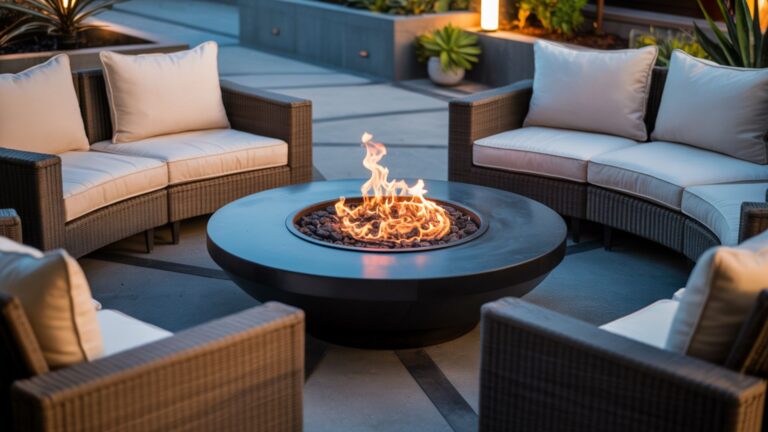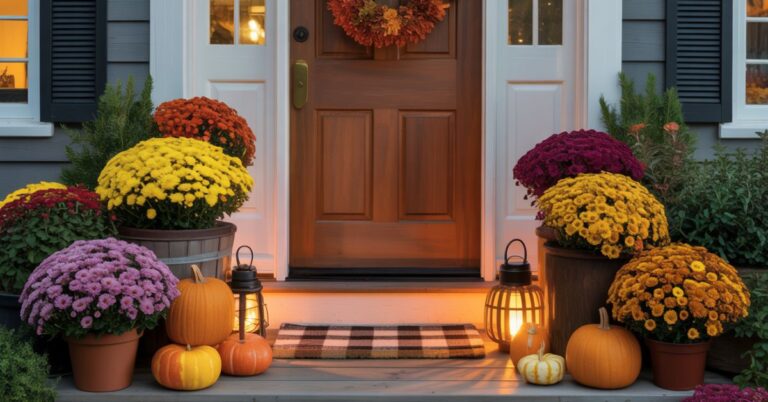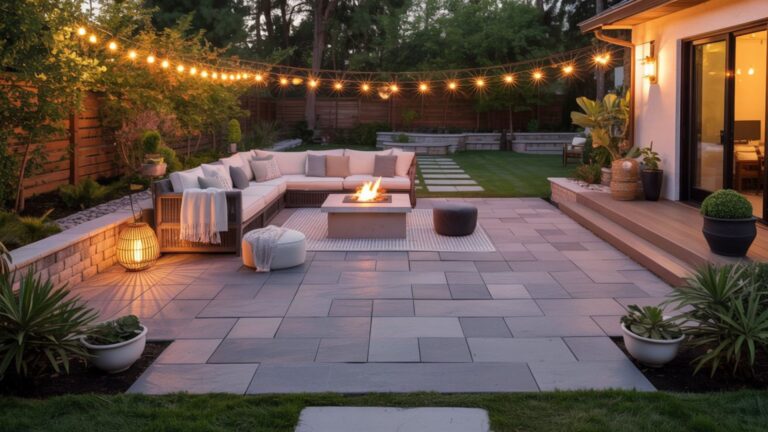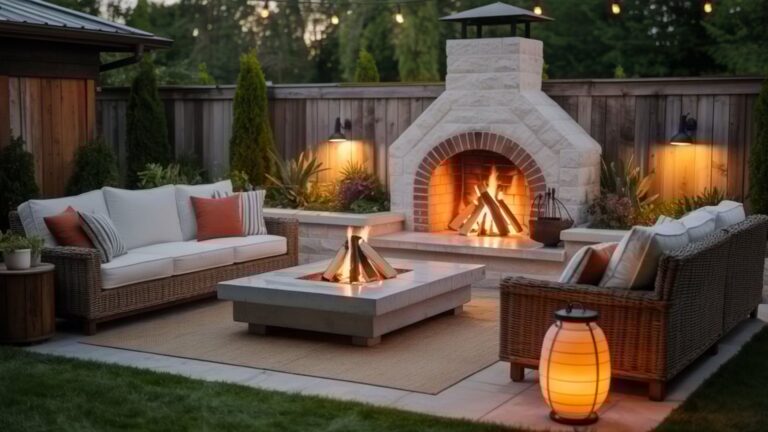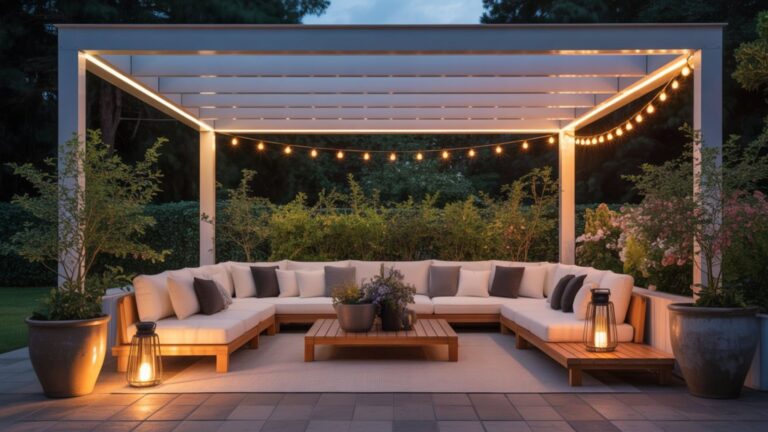Low Light House Plants for Gardens in Dim Spaces
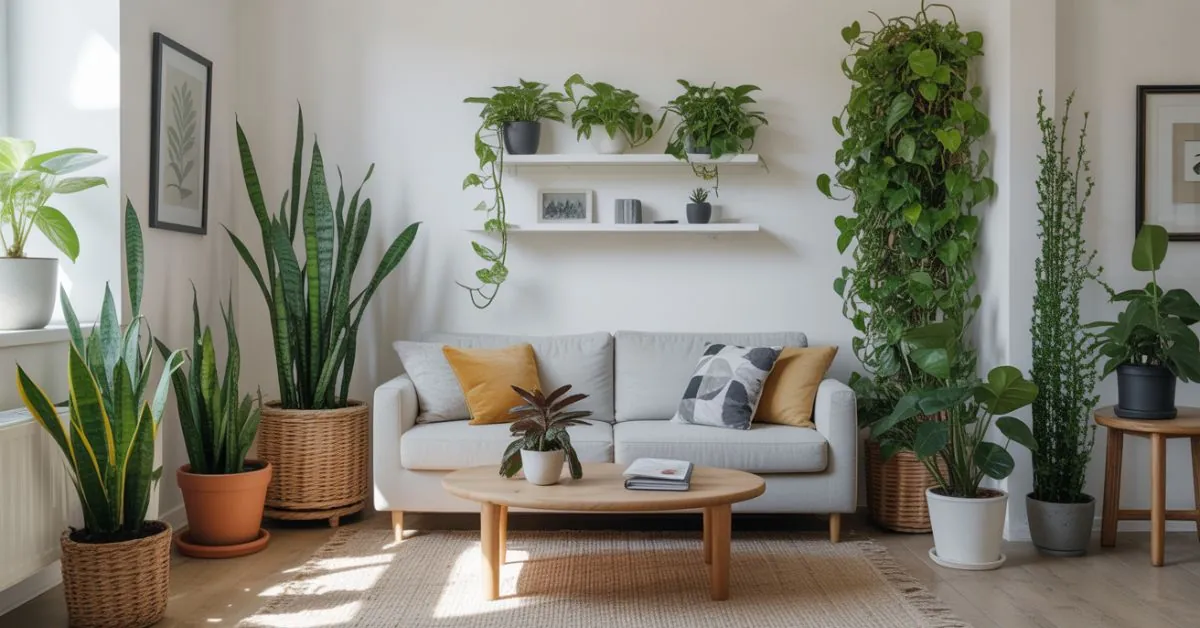
Does your home feel darker than a cave, yet you’re still dreaming of lush greenery cascading from every corner? You’re not alone. Millions of plant lovers struggle with the same dilemma: wanting beautiful low light house plants that can survive in apartments with tiny windows, basement offices, or north-facing rooms that barely see direct sunlight. The frustration of watching expensive plants slowly fade away in your dimly lit space is real and costly. But here’s the game-changer: dozens of stunning houseplants actually prefer low light conditions and will transform your shadowy spaces into vibrant, air-purifying sanctuaries without demanding constant sunbathing sessions.
Low light house plants bring life and freshness into spaces where sunlight is limited, making them perfect for apartments, offices, and shaded rooms. These resilient indoor plants not only thrive in dim conditions but also improve air quality and add natural beauty to any setting. From snake plants to pothos and ZZ plants, low light varieties require minimal care while creating a calming, green atmosphere. Whether you’re a beginner or an experienced plant lover, incorporating low light house plants is a simple way to transform dull corners into vibrant, welcoming spaces.
What Are Low Light House Plants and Why Do They Matter?
Low Light House Plants are indoor plant varieties specifically adapted to thrive in environments with minimal natural sunlight, typically receiving less than 50 footcandles of light or areas located more than six feet from windows. Unlike their sun-loving counterparts, Low Light House Plants have evolved unique physiological adaptations that allow them to photosynthesize efficiently in dim conditions, making them an essential choice for shaded interiors.
Understanding light requirements is crucial for the success of Low Light House Plants. Low light doesn’t mean no light—it refers to indirect natural light or artificial indoor lighting that creates soft, diffused illumination. Low Light House Plants typically flourish in north-facing windows, room corners, or spaces illuminated primarily by LED grow lights or fluorescent bulbs, proving their adaptability in diverse indoor environments.
The beauty of Low Light House Plants lies in their resilience and low maintenance. Most Low Light House Plants can tolerate irregular watering schedules, temperature fluctuations, and even occasional neglect, making them perfect for busy professionals, frequent travelers, or beginner gardeners. Low Light House Plants are particularly valuable in modern homes where energy-efficient windows and urban living conditions limit natural sunlight, yet homeowners still want vibrant greenery indoors.
Best Low Light House Plants for Beginners
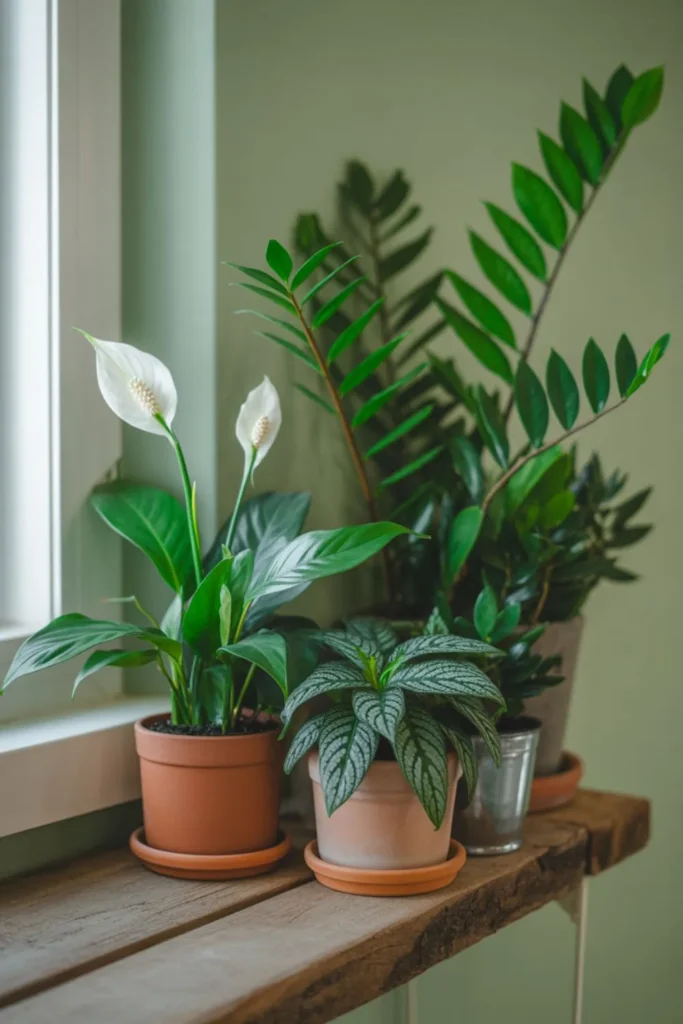
ZZ Plant (Zamioculcas zamiifolia)
The ZZ Plant stands as one of the easiest low-light plants with unique light and dark leathery elliptical leaves, typically reaching 2 to 3 feet tall and thriving in heat and drought conditions. This drought-tolerant houseplant stores water in its thick stems and waxy leaves, making it virtually indestructible for beginners.
ZZ plants excel in fluorescent office lighting and can survive weeks without water. Their glossy, architectural foliage adds modern sophistication to any space while requiring minimal intervention. Simply water when the soil feels completely dry, which typically occurs every 2-3 weeks.
Snake Plant (Sansevieria trifasciata)
Snake plants are famous for their low-light tolerance, being hardy and resilient while requiring little water, making them perfect for people on the go with their sword-like dark green, often variegated leaves. These air purifying plants work overtime while you sleep, converting carbon dioxide to oxygen during nighttime hours.
The architectural beauty of Sansevieria varieties makes them ideal statement pieces for modern interiors. They tolerate extreme neglect, making them perfect office plants that can handle weekend abandonment and irregular care schedules.
Pothos (Epipremnum aureum)
Pothos ranks among excellent beginner-friendly low-light houseplants that require minimal care and tolerate irregular watering. These trailing houseplants adapt to various light conditions while producing cascading vines that can stretch over 10 feet when properly maintained.
Golden Pothos, Marble Queen, and Jade Pothos varieties offer different color variations to match your interior design preferences. They root easily in water, making propagation simple for expanding your plant collection or sharing with friends.
Read More About: 50+ Terrace Garden Ideas for a Creative Rooftop Patio
How Do Low Light House Plants Adapt to Dim Conditions?
Shade adaptation mechanisms in Low Light House Plants involve fascinating biological processes that maximize photosynthetic efficiency in limited light. These Low Light House Plants typically develop larger, thinner leaves with increased chlorophyll density to capture every available photon of light energy and sustain healthy growth indoors.
Many Low Light House Plants exhibit slower growth rates, which actually benefits indoor gardeners by reducing pruning requirements and maintaining manageable sizes. Because of their efficient adaptations, Low Light House Plants require less water and fewer nutrients, while extended intervals between repotting make them perfect for low-maintenance care.
Photosynthesis optimization in Low Light House Plants relies on enhanced chloroplast structures and modified cellular arrangements that improve light absorption. Some Low Light House Plants even develop unique leaf textures or patterns that help reflect and concentrate available light toward photosynthetic tissues.
The evolutionary advantage of Low Light House Plants lies in their natural resistance to common indoor plant problems such as leaf scorch, rapid moisture loss, and temperature stress. By being pre-adapted to shaded environments, Low Light House Plants thrive indoors where typical sun-loving garden plants often struggle.
Which Low Light House Plants Are Best for Air Purification?
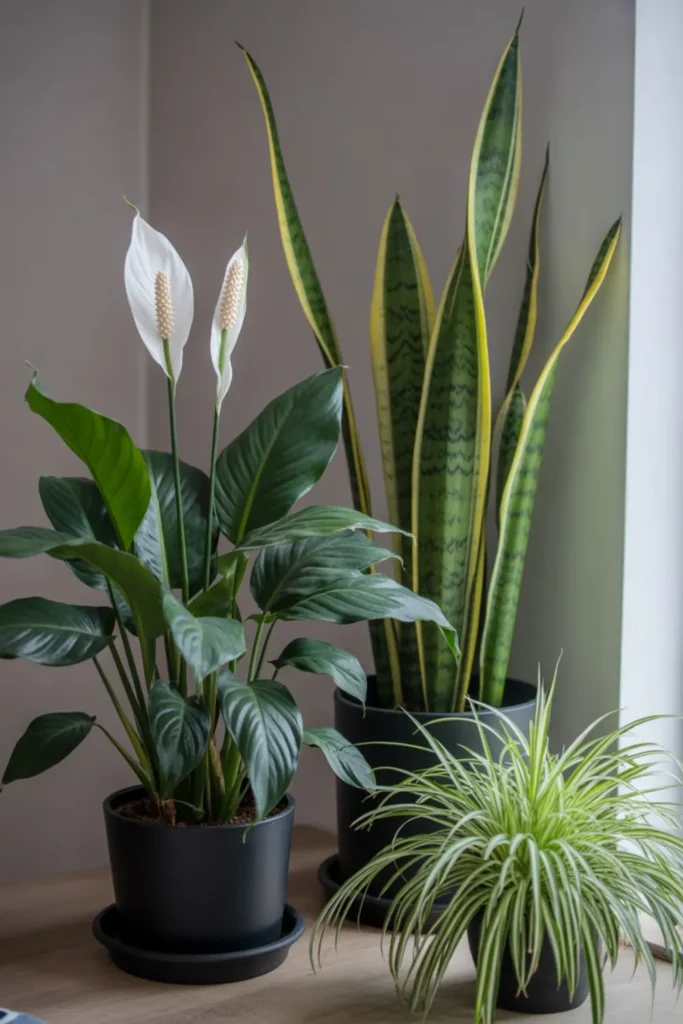
Peace Lily (Spathiphyllum wallisii)
Peace lilies bloom indoors in low light when given the right growing conditions, making them one of the elegant flowering options for dim spaces. NASA’s Clean Air Study consistently ranks Peace Lilies among top air purifying houseplants for removing formaldehyde, benzene, and trichloroethylene from indoor environments.
These flowering houseplants produce elegant white blooms throughout the year when properly cared for. Their dark green foliage provides excellent contrast while their drooping leaves serve as natural humidity indicators they’ll visibly wilt when thirsty, making watering schedules foolproof.
Spider Plant (Chlorophytum comosum)
Spider plants rank among easy-care options for gaining confidence while expanding your indoor jungle, and they bloom in low light with proper growing conditions. These pet-safe houseplants excel at removing carbon monoxide and xylene while producing numerous plantlets that create natural air circulation.
Spider plant propagation creates endless opportunities for expanding your collection. The characteristic plantlet runners develop automatically, producing ready-to-root baby plants that can be shared with friends or used to fill additional spaces throughout your home.
Dracaena Varieties
The Dracaena Janet Craig is a resilient, low-maintenance houseplant known for its glossy, dark green leaves that grow in dense clusters and thrives in low to moderate light. Dracaena marginata, Dracaena fragrans, and Dracaena janet craig varieties offer diverse foliage colors while consistently ranking among NASA’s recommended air-purifying species.
These statement plants can reach impressive heights indoors while maintaining manageable care requirements. Their architectural growth patterns make them perfect for filling empty corners or creating natural room dividers in open-concept living spaces.
What Are the Most Beautiful Flowering Low Light House Plants?
African Violet (Saintpaulia ionantha)
African violets are among houseplant varieties that will flower in low light when given the right growing conditions. These compact flowering plants produce vibrant purple, pink, or white blooms throughout the year when provided with consistent moisture and indirect bright light.
African violet care requires attention to watering techniquesbottom watering prevents leaf damage while maintaining optimal soil moisture. Their fuzzy heart-shaped leaves create attractive foliage even during non-blooming periods, making them excellent tabletop plants.
Anthurium (Anthurium andraeanum)
Red anthurium and other anthurium varieties bloom indoors in low light when given appropriate growing conditions. These tropical houseplants produce long-lasting, waxy flowers in brilliant reds, pinks, or white that can persist for months with proper care.
Anthurium flowering requires consistent humidity levels and well-draining potting mix. Their glossy, heart-shaped leaves provide year-round beauty while their exotic blooms create striking focal points in contemporary interior design.
Bromeliad Species
Bromeliads are among the few houseplant varieties that will flower in low light when given the right growing conditions. These epiphytic plants produce spectacular central flowers in vibrant colors while their architectural foliage creates dramatic texture contrasts.
Bromeliad care involves maintaining the central water reservoir and providing high humidity levels. After flowering, these plants produce offsets that continue the growing cycle, creating long-term indoor garden sustainability.
How Do You Care for Low Light House Plants Successfully?
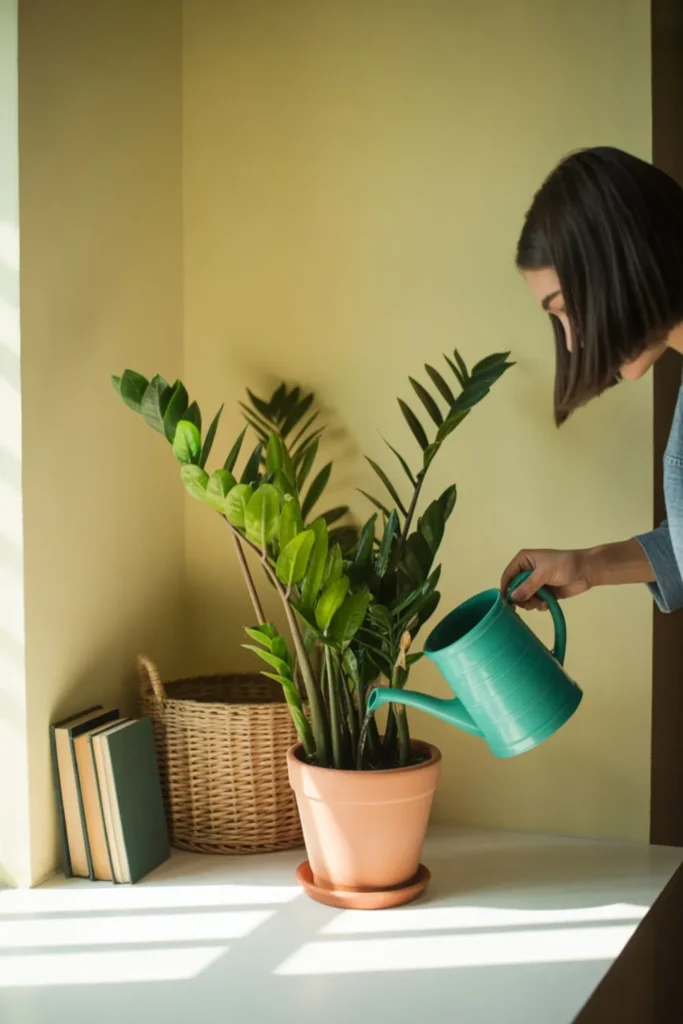
Watering Strategies for Dim Light Conditions
Low light watering requires modified techniques since plants photosynthesize less actively and process water more slowly. The general rule involves checking soil moisture 2-3 inches deep before watering, typically extending intervals to every 10-14 days during winter months.
Overwatering prevention becomes crucial in low light environments where plants cannot quickly process excess moisture. Well-draining potting soil mixed with perlite or bark chunks improves aeration while preventing root rotthe most common cause of houseplant death in dim conditions.
Seasonal watering adjustments reflect changing light levels throughout the year. Summer months may require weekly watering, while winter intervals can extend to bi-weekly or monthly schedules depending on indoor heating and humidity levels.
Fertilizing Low Light House Plants
Low light fertilizing requires reduced frequency and diluted concentrations since plants grow more slowly and require fewer nutrients. Balanced liquid fertilizer applied monthly during growing season (spring through early fall) provides adequate nutrition without overwhelming root systems.
Organic fertilizer options like compost tea or fish emulsion release nutrients gradually while improving soil structure. Avoid slow-release fertilizer pellets in low light conditions since they can create nutrient buildup when plants cannot quickly utilize available minerals.
Winter fertilizing should be suspended entirely since most low light house plants enter dormancy periods with minimal growth activity. Resume feeding programs when daylight hours increase and new growth becomes visible.
Humidity and Temperature Requirements
Indoor humidity levels between 40-60% optimize low light plant health while preventing common problems like brown leaf tips or pest infestations. Humidity trays, pebble trays, or room humidifiers create ideal microclimates around plant collections.
Temperature stability matters more than specific ranges for most shade-tolerant species. Avoid placing plants near heating vents, air conditioning units, or drafty windows that create temperature fluctuations exceeding 10-15 degrees daily.
Grouping plants together creates natural humidity zones while improving air circulation. This companion planting approach mimics natural forest conditions where understory plants thrive in stable, humid environments.
Read More About: 62+ Stunning Terrace Ideas to Elevate Your Rooftop Space
What Are the Best Low Light House Plants for Specific Rooms?
Bedroom Plants for Better Sleep
Bedroom air purifiers like Snake Plants and Aloe Vera convert carbon dioxide to oxygen during nighttime hours, potentially improving sleep quality. These night-active plants require minimal light while providing maximum air-cleaning benefits.
Peace Lilies excel in bedroom environments due to their ability to increase humidity levels naturally while removing harmful volatile organic compounds. Their white flowers create calming visual elements that complement bedroom decor.
Pothos varieties thrive in bedroom lighting conditions while their trailing growth creates natural privacy screens or living art installations. Marble Queen Pothos adds subtle color variation without overwhelming neutral bedroom color schemes.
Office Plants for Productivity
Desk plants like ZZ Plants and Chinese Evergreens tolerate fluorescent office lighting while requiring minimal maintenance during busy work schedules. Their air-purifying qualities help combat sick building syndrome in sealed office environments.
Snake Plant varieties serve as excellent office partitions while providing natural sound absorption and visual privacy. Their upright growth habit maximizes floor space utilization in cramped office environments.
Spider Plants hanging from office ceiling hooks or placed on filing cabinets create vertical gardens that improve workplace aesthetics without consuming valuable desk real estate. Their cascading plantlets add dynamic visual interest to sterile office environments.
Bathroom Plants That Love Humidity
High humidity plants like Boston Ferns and Cast Iron Plants thrive in bathroom environments where steam showers create tropical microclimates. These moisture-loving species actually prefer the consistent humidity levels found in well-ventilated bathrooms.
Philodendron varieties excel in bathroom lighting conditions while their heart-shaped leaves create spa-like atmospheres. Heartleaf Philodendron trailing from shower shelves or bathroom windowsills adds natural beauty to utilitarian spaces.
Air plants (Tillandsia species) require no soil while absorbing moisture directly from humid bathroom air. These epiphytic plants mount easily on bathroom walls or shower caddies without creating maintenance complications.
How Can You Troubleshoot Common Low Light House Plant Problems?
Yellow Leaves and Overwatering Issues
Yellow leaves typically indicate overwatering problems in low light conditions where plants cannot process excess moisture efficiently. Root inspection reveals brown, mushy roots that require immediate attention through soil replacement and watering schedule adjustment.
Overwatering recovery involves removing affected foliage, checking root health, and repotting in fresh, well-draining soil. Watering reduction to bi-weekly or monthly schedules allows root systems to recover while preventing future moisture-related problems.
Soil moisture meters provide accurate readings that eliminate guesswork in low light watering. These digital tools measure moisture levels 4-6 inches deep, ensuring plants receive appropriate hydration without waterlogged conditions.
Pest Management in Low Light Conditions
Low light pest problems often involve fungus gnats attracted to moist soil conditions and spider mites that thrive in dry indoor air. Integrated pest management combines physical removal, environmental modification, and organic treatments.
Neem oil applications provide effective organic pest control while improving leaf shine and overall plant health. Weekly treatments during active infestations, followed by monthly maintenance applications, prevent recurring pest problems.
Beneficial insects like predatory mites control spider mite populations naturally without chemical interventions. Yellow sticky traps capture flying pests while helping monitor infestation severity and treatment effectiveness.
Growth and Propagation Tips
Low light propagation requires patience since root development proceeds more slowly in dim conditions. Water propagation works well for Pothos, Philodendrons, and Spider Plants, allowing root observation throughout the development process.
Stem cutting preparation involves clean, sharp cuts below leaf nodes where root development occurs naturally. Rooting hormone applications accelerate root formation in challenging low light environments.
Propagation timing during spring months takes advantage of increasing daylight hours and natural growth cycles. Heat mats provide bottom warmth that encourages root development when ambient temperatures remain cool.
What Are the Latest Trends in Low Light House Plant Design?
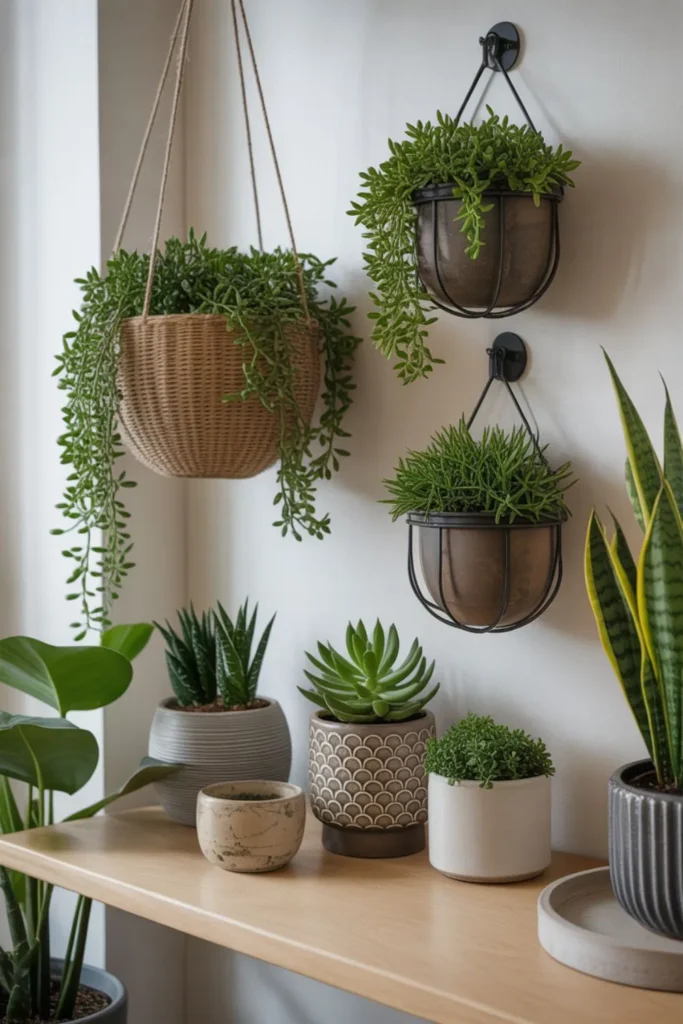
Modern Plant Styling Techniques
Contemporary plant styling emphasizes architectural foliage and sculptural growth patterns that complement modern interior design. Minimalist plant displays featuring single statement specimens create dramatic focal points without overwhelming space.
Vertical gardens and living walls maximize growing space in small apartments while creating natural art installations. Modular planting systems allow easy rearrangement and expansion as plant collections grow.
Neutral containers in matte black, white ceramic, or natural wood provide versatile backgrounds that highlight plant textures without competing for attention. Geometric planters add contemporary edge while maintaining focus on plant beauty.
Innovative Growing Technologies
LED grow lights specifically designed for low light houseplants provide supplemental illumination without excessive heat generation. Full spectrum LED panels support both photosynthesis and flowering in challenging indoor environments.
Self-watering planters incorporate reservoir systems that maintain consistent soil moisture without overwatering risks. These automated solutions benefit travelers and busy professionals who struggle with watering schedules.
Smart plant monitors track soil moisture, light levels, and temperature while sending smartphone alerts when plants require attention. These IoT devices eliminate guesswork while building plant care confidence.
Frequently Asked Questions
What qualifies as low light for houseplants?
Low light refers to areas receiving less than 50 footcandles of light, typically located more than 6 feet from windows or spaces with only artificial lighting. Most low light house plants thrive in north-facing windows or rooms illuminated by fluorescent bulbs.
Can low light plants survive in rooms with no windows?
Yes, many low light tolerant plants can survive in windowless rooms when provided with adequate artificial lighting. LED grow lights or fluorescent fixtures running 12-16 hours daily provide sufficient energy for photosynthesis and healthy growth.
How often should I water low light house plants?
Low light watering typically requires 10-14 day intervals since plants photosynthesize less actively and process water more slowly. Check soil moisture 2-3 inches deep before watering, and adjust frequency based on seasonal changes and indoor humidity levels.
Which low light house plants are safe for pets?
Pet-safe options include Spider Plants, Boston Ferns, Parlor Palms, and Prayer Plants. Always verify plant toxicity through ASPCA databases before introducing new species to homes with curious cats or dogs.
Do low light house plants really purify indoor air?
NASA research confirms that many low light house plants effectively remove common indoor pollutants like formaldehyde, benzene, and trichloroethylene. Snake Plants, Peace Lilies, and Spider Plants rank among the most effective natural air purifiers.
What’s the biggest mistake people make with low light plants?
Overwatering represents the most common error since people assume plants need frequent water to compensate for low light conditions. In reality, reduced photosynthesis means plants require less frequent watering and can be damaged by excessive moisture in poorly lit environments.
Conclusion
Creating thriving indoor gardens with low light house plants transforms even the darkest spaces into vibrant, healthy environments that improve both air quality and mental wellbeing. These resilient plant varieties offer endless possibilities for personalizing your living space while requiring minimal maintenance and expertise. From architectural Snake Plants that tolerate complete neglect to flowering Peace Lilies that bloom year-round, there’s a perfect shade-tolerant species for every home and lifestyle.
The key to success lies in understanding that low light adaptation actually makes these plants more forgiving and suitable for busy modern lifestyles. Start with proven winners like Pothos, ZZ Plants, or Spider Plants to build confidence, then gradually expand your collection with more specialized varieties. Remember that proper watering techniques and occasional fertilizing matter more than perfect lighting conditions, these plants have evolved to thrive in the exact conditions your home naturally provides.

